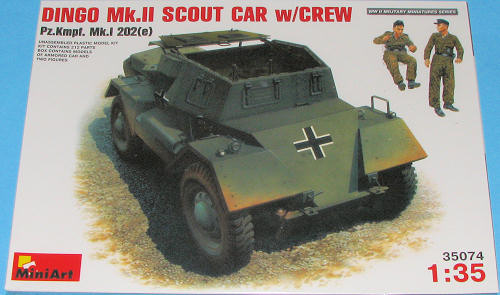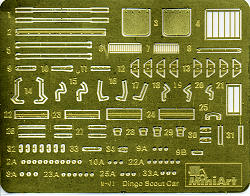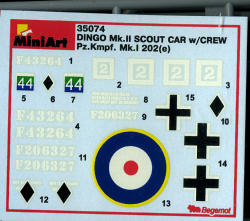
MiniArt 1/35 Dingo Mk.II with crew
| KIT #: | 35074 |
| PRICE: | $51.50 SRP |
| DECALS: | Three options |
| REVIEWER: | Scott Van Aken |
| NOTES: | Includes two crew figures. |

| HISTORY |
In 1938 the British War Office issued a specification for a scouting vehicle. Out of three designs submitted by Alvis, BSA and Morris, the one by BSA was selected. The actual production was passed to Daimler, which was a vehicle manufacturer in the BSA group of companies. The vehicle was officially designated Daimler Scout Car, but became widely known as Dingo, which was the name of the competing Alvis prototype.
Arguably one of the finest armoured fighting vehicles built in Britain during the war, the Dingo was a small two-man armoured car. It was well protected for its size with 30 mm of armour at the front. The engine was located at the rear of the vehicle. One of the ingenious features of Dingo was the transmission; a pre-selector gearbox and fluid flywheel that gave five speeds in both directions. Original version had four-wheel steering; however this feature was dropped in Mk II because inexperienced drivers found the vehicle hard to control.| THE KIT |
 MiniArt has been gaining a reputation for well engineered and well detailed kits. From the looks of this one, that reputation is well earned. Molded in a grey plastic, the detailing and quality of the mold
MiniArt has been gaining a reputation for well engineered and well detailed kits. From the looks of this one, that reputation is well earned. Molded in a grey plastic, the detailing and quality of the mold ing is first rate. No flash, no sink areas, few ejector marks and those in areas that will be hidden or easily sanded away. The 212 parts are located on 6 sprues and one goodly sized photo etch fret. In fact, many of the really small parts (like bolt heads) are on the photo etch fret. This fret is covered on both sides by a somewhat thick clear plastic film. The etched parts are attached to the fret by a very fine line so do require some cutting to set them free. I think the plastic film is to help keep them in place until actually placed on the kit. This photo etch is also used for hinges, grab handles, screens and the usual fine detail pieces.
ing is first rate. No flash, no sink areas, few ejector marks and those in areas that will be hidden or easily sanded away. The 212 parts are located on 6 sprues and one goodly sized photo etch fret. In fact, many of the really small parts (like bolt heads) are on the photo etch fret. This fret is covered on both sides by a somewhat thick clear plastic film. The etched parts are attached to the fret by a very fine line so do require some cutting to set them free. I think the plastic film is to help keep them in place until actually placed on the kit. This photo etch is also used for hinges, grab handles, screens and the usual fine detail pieces. ee in the image, the wheels are plastic and have molded on tires. These are separate from any sprue. The kit includes two crew figures to add some interest to the kit.
ee in the image, the wheels are plastic and have molded on tires. These are separate from any sprue. The kit includes two crew figures to add some interest to the kit.| CONCLUSIONS |
So this one pretty much completes the Triumverate of Dingos. We now have kits of all three major versions. It looks like a very nice kit and should make into an equally interesting model.
| REFERENCES |
August 2009
Thanks to www.dragonmodelsusa.com for the preview kit. Get yours today at your local shop or on-line retailer. If you would like your product reviewed fairly and fairly quickly, please contact the editor or see other details in the Note to Contributors.